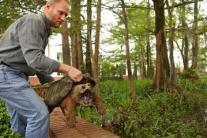Dr.
50-pound turtle takes a wrong turn, ends up in classroom
Thu, 04/30/2015 - 8:50amAn alligator snapping turtle that wandered out of Cypress Lake during recent heavy rains was returned to its home Wednesday.
But not before biology students at the University of Louisiana at Lafayette got the chance to check out the prehistoric-looking animal up close.
Dr. Brad Moon, an associate professor of biology, said students found the turtle ambling along the brick wall that rims Cypress Lake. It was taken to nearby Wharton Hall.
The adult female, which Moon estimates to be between 30-50 years old, was kept safely in a lab. She was weighed and measured, tipping the scales at 50 pounds, and measuring 30 inches long and 16 inches wide.
Moon also was able to show the turtle to undergraduate and graduate students, including some who are studying herpetology, a branch of zoology that centers on reptiles and amphibians.
“In all the years I’ve been teaching, we’ve never had the opportunity to see one up close like that,” said Moon, who has taught at the University for about 15 years.
Michael Fulbright, 28, a doctoral student in biology, was among a small group of students who discovered the turtle.
His main research interest is the functional morphology and digestive physiology of turtles, or understanding “how turtles bite and digest things.”
“Personally, this was incredibly exciting. I’ve actually looked for this species for the last four or five years. They’re very hard to find,” he said.
With their spiked shells, and thick, scaled tails, alligator snapping turtles are often referred to as the dinosaur of the turtle world, according to nationalgeographic.com.
They can live to up to 100 years old, and spend most of their time submerged in water. They are found almost exclusively in waterways of the southeastern United States.
Fulbright said Cypress Lake, a diverse ecosystem located in the heart of campus, was one of the key reasons he decided to study at UL Lafayette.
“When I came to visit the university to see if I was going to come here for my doctoral research, Cypress Lake was one of the biggest selling points, the natural beauty, the diversity of animals,” he said.
Cypress Lake holds alligators, several species of turtles, and fish such as bass, sunfish, and garfish. Birds, such as hawks, nest in the lake’s cypress trees, and water birds, such as herons and egrets, wade its shores.
Moon consulted with the Louisiana Department of Wildlife and Fisheries, and the University’s Office of Environmental Health and Safety, before returning the turtle to Cypress Lake.
Joey Pons, environmental health and safety director at UL Lafayette, said it is unlikely that the normally reclusive turtle will leave the water again.
But, if it should, one option would be to have the Louisiana Department of Wildlife and Fisheries relocate it.
“As long as people respect the turtles, and don’t antagonize them, there’s little if any chance of anything bad happening,” Pons said.
Caption: Dr. Brad Moon, an associate professor of biology, returns an alligator snapping turtle to Cypress Lake on campus.

